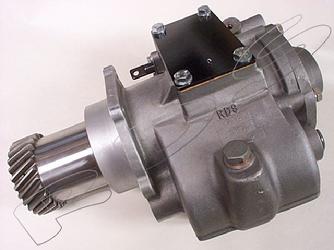| Fairey Overdrives for Series Land Rovers |
 |
| The Fairey Overdrive is a bolt on unit |
|
|
 |
| This mechanical overdrive, an authorized accessory by Land Rover, first appeared in the 1970's |
|
|
The Fairey Overdrive unit first appeared in the early 1970's in response to the rapid rise in worldwide fuel prices. Land Rover felt the sales pinch quickly and looked for every opportunity to make the Series 88" and 109" Land Rovers more fuel efficient.
The overdrive is a mechanical unit that can be engaged in any gear at any speed. Practically speaking, its greatest value today is in 3rd gear, when it provides added speed for acceleration onto highways, and in 4th gear, when it permits lower engine rpm to continue at a constant speed.
The overdrive works by changing the final drive gear from the transfer case to the propshaft[s]. To install it, you remove the end plate on the transmission and the final drive gear. You repalce it with the self contained overdrive unit. The only hole that requires drilling is in the side of the transmission tunnel, through which you add a selector lever.
Fairey remained a self-supporting company through the 1990's when it was purchased by Superwinch. In North America, Rovers Down South, based in New Orleans, LA, became the primary source for Fairey Overdrive rebuilds, repairs, parts and service.
For more information on the Fairey Overdrive, the Land Rover FAQ, created by Dixon Kenner and Benjamin Smith, has posted a copy of the original Fairey installation manual.
|
| The Land Rover Life With A Fairey Overdrive |
The two 1966 Series II-A Land Rover owned by Jeff Aronson provide a good testing ground for the Fairey Overdrive. The QE I had an overdrive installed in the mid-1990's, and the QM I has never remained without one.
The overdrive does enable a Series Rover to hold highway speeds of 65 mph at lower engine rpm than a comparable Rover without an overdrive; the reality in daily use is the Rover enthusiast simply uses the overdrive as a way to cruise at hgher highway speeds - thus negating the 16% gear advantage and the resultant improvement in miles per gallon.
With only a small gear oil capacity the overdrive does need more maintenance than the average Land Rover transmission or transfer case. Serious off roaders claim the final gears are not as rugged as the standard Land Rover item, but this might be a function of unit age rather than metallurgy. The Fairey was an approved option by Land Rover, and thus supported by Land Rover dealers worldwide.
It adds another level of gear noise while underway but it's definitely less instrusive than the gear noise of a non-overdrive equipped Land Rover. Also, the use of the overdrive in certain driving situations, such as merging onto an interstate highway, is certainly advantageous. You can acceleate up to 55 mph in 3rd with overdrive engaged, whereas without the overdrive you're lucky to get to 50 mph in 3rd before you must shift into 4th.
The downside is that there's another unit to go wrong, and unless you change the gear oil routinely, the overdrive will begin to require rebuilding after 100,000 miles of regular use. However, parts and rebuilding services remain available through Rovers Down South.
There are other options. Some enthusiasts prefer Toro overdrive units. Rovers North offers a transfer case replacement that accomplishes the same goals without adding another unit. Rocky Mountain also manufactures its own unit, named the Roverdrive.
|
|